1. Introduction
Transformer is an important power equipment in the power system, and its stable operation is crucial to the normal operation of the power system [1]. However, transformers may have various faults in long-term operation, such as winding short-circuit, insulation aging, etc. These faults will affect the performance of the transformer and may even lead to the destruction of the transformer [2,3]. Therefore, timely and accurate detection of transformer faults is an important measure to ensure the safe and stable operation of the power system [4].
Traditional transformer fault detection methods mainly rely on manual inspection and laboratory testing, and these methods have problems such as low efficiency, high cost, and susceptibility to subjective factors [5]. With the development of machine learning technology, more and more researchers began to explore the application of machine learning in transformer fault detection [6]. Machine learning can automatically learn the characteristics of transformer under normal operation and fault state by training and learning from the data, so as to achieve the automatic detection of transformer faults [7,8]. In recent years, more and more researchers have begun to use machine learning methods for transformer fault detection, and certain research progress has been made [9].
Among them, the commonly used machine learning methods include neural networks, support vector machines, decision trees and so on. These methods can learn the characteristics of transformer faults by training on a large amount of transformer operation data, so as to achieve accurate detection and diagnosis of transformer faults [10]. The research of machine learning in transformer fault detection provides new ideas and methods to improve the accuracy and efficiency of transformer fault detection, which has a broad application prospect.
2. Introduction to data set parameters
In this paper, the public dataset of transformer fault detection from UCL database is selected, the current and voltage information is shown in Table 1, and the transformer state information is shown in Table 2.
Table 1. Current and voltage parameters.
Parameter name | Hidden meaning |
VL1 | phase line 1 |
VL2 | phase line 2 |
VL3 | phase line 3 |
IL1 | current line 1 |
IL2 | current line 2 |
IL3 | power line 3 |
VL12 | voltage line 1 2 |
VL23 | voltage line 2 3 |
VL31 | voltage line 3 1 |
INUT | neutral current |
Table 2. Transformer status parameters.
Parameter name | Hidden meaning |
OTI | Oil Temperature Indicator |
WTI | Winding Temperature Indicator |
ATI | Ambient temperature indicator |
OLI | Oil level indicator |
OTI A | Oil temperature indicator alarm |
OTI T | Oil temperature indicator tripped |
MOG A | Magnetic Oil Level Indicator |
Winding temperature indicator, oil temperature indicator alarm, oil temperature indicator trip and magnetic oil level indicator are four very important indicators reflecting the working status of the transformer, and we can take these four indicators as target variables to judge the working status of the transformer by whether these four indicators are abnormal.
3. Pearson correlation analysis
Current and voltage parameters and transformer state parameters may have some intrinsic correlations and laws, correlation analysis of each parameter and drawing correlation heat map, the results are shown in Figure 1.
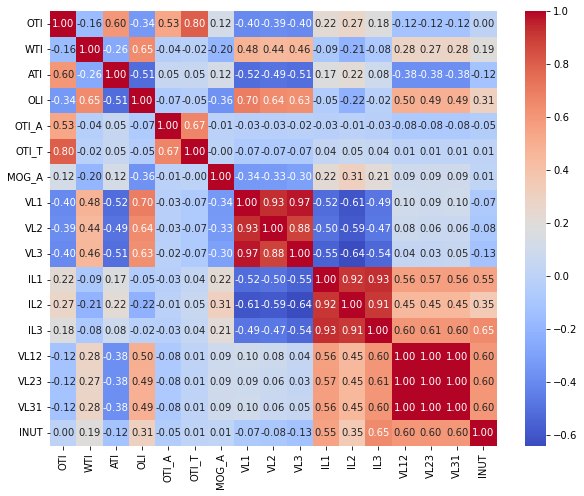
Figure 1. Correlation heat map. (Photo credit: Original)
The closer the correlation coefficient is to 1, the stronger the positive correlation is; the closer the correlation coefficient is to -1, the stronger the negative correlation is. From the correlation heat map, it can be seen that there is a strong positive correlation between each parameter, which can be carried out later machine learning research to further explore the intrinsic relationship and the law that exists between the parameters.
4. Machine learning model
Machine learning algorithms are a kind of artificial intelligence technology, the principle of which is to automatically discover the laws and patterns in the data by learning and analysing a large amount of data, and use these laws and patterns to make predictions and decisions.
Specifically, machine learning algorithms can be divided into three types: supervised learning, unsupervised learning and reinforcement learning. Among them, supervised learning refers to training a model with existing labelled data (i.e., data with known inputs and outputs) to enable it to predict and classify new input data. Unsupervised learning, on the other hand, refers to the discovery of patterns and structures in data through operations such as clustering and dimensionality reduction of the data in the absence of labelled data. Reinforcement learning, on the other hand, enables the model to learn and make optimal decisions on its own by interacting with the environment.Regardless of the type of machine learning algorithm, the basic principle is to continuously optimise the parameters and structure of the model by learning and analysing the data so that it can make more accurate predictions and decisions.
Winding temperature indicator, oil temperature indicator alarm, oil temperature indicator trip and magnetic oil level indicator are four very important indicators reflecting the working status of the transformer, we can take these four indicators as the target variables, take the current and voltage parameters as the input variables, divide the dataset into a training set, a validation set and a test set according to the ratio of 6:2:2, and introduce 12 kinds of machine learning models, respectively, for the winding temperature indicator, the oil temperature indicator alarm, the oil temperature indicator trip and the magnetic oil level indicator. indicator, oil temperature indicator alarm, oil temperature indicator trip and magnetic oil level indicator values are predicted, and the working status of the transformer is observed in real time by predicting the transformer state parameters, and the prediction accuracies of each model for the winding temperature indicator, oil temperature indicator alarm, oil temperature indicator trip and magnetic oil level indicator are shown in Fig. 2.
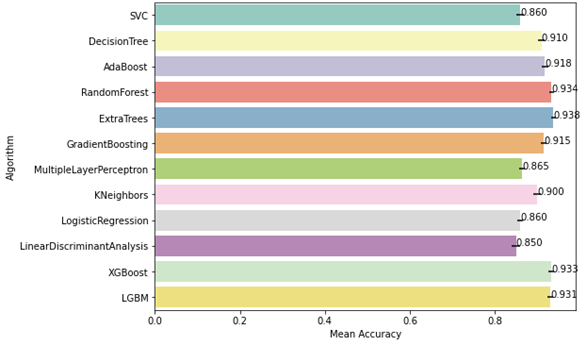
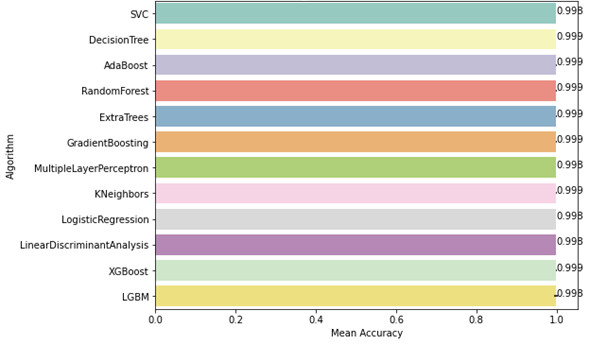
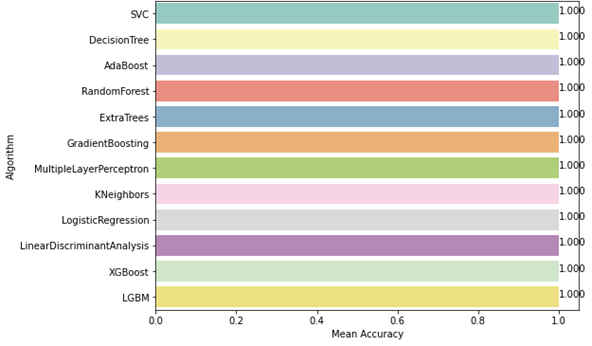
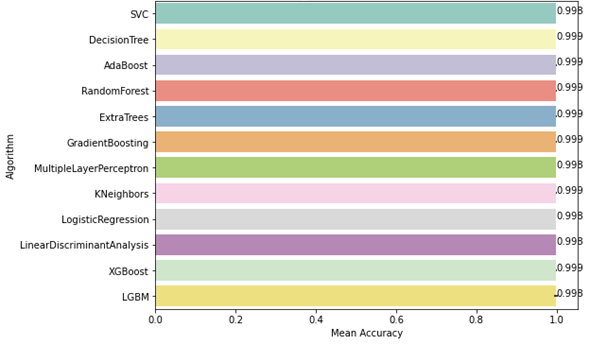
Figure 2. Predictive accuracy of group temperature indicators, oil temperature indicator alarms, oil temperature indicator trips and magnetic oil level indicators. (Photo credit: Original)
As can be seen from the results, the accuracy of the 12 machine learning models in the prediction of winding temperature reaches more than 85%, especially the accuracy of the Extratrees model reaches 93.8%, which can accurately monitor the winding temperature in real time and judge the abnormal state of the winding; in the prediction of the oil temperature, the prediction accuracy of the 12 machine learning models reaches more than 99%, which can predict the oil temperature very accurately. In terms of oil temperature, the prediction accuracy of all 12 machine learning models reaches more than 99%, which can predict the oil temperature very accurately; in terms of the prediction of tripping of the oil temperature indicator, the prediction accuracy of all 12 machine learning models reaches 100%, which indicates that the machine learning models are very accurate in predicting the oil temperature; in terms of the prediction of magnetic oil level, the prediction accuracy of all 12 machine learning models reaches more than 90%, which indicates that the machine learning models can predict the magnetic oil level very well.
5. Conclusion
In this paper, four important indicators of transformers are predicted by introducing 12 machine learning models to monitor the operating status of transformers in real time. Among them, the target variables are winding temperature indicator, oil temperature indicator alarm, oil temperature indicator trip and magnetic oil level indicator, the input variables are current and voltage parameters, and the dataset is divided into training set, validation set and test set according to the ratio of 6:2:2.
For the prediction of winding temperature, all the 12 machine learning models achieved an accuracy of more than 85%, with the Extratrees model achieving an accuracy of 93.8%. This indicates that the machine learning models can accurately monitor the winding temperature in real time and determine whether the working condition of the winding is abnormal.
In the prediction of oil temperature, the prediction accuracy of all 12 machine learning models reached more than 99%. This shows that the machine learning models can predict the oil temperature very accurately, so that the abnormal state of the transformer can be detected in time.
On the prediction of tripping of the oil temperature indicator, the prediction accuracy of all 12 machine learning models reaches 100%. This indicates that the machine learning models have very high accuracy in predicting the oil temperature, which can warn the abnormal state of the transformer in time.
On the prediction of magnetic oil level, the prediction accuracy of all 12 machine learning models reaches more than 90%. This indicates that the machine learning models can predict the magnetic oil level very well, so as to detect the abnormal state of the transformer in time.
Taking the above conclusions together, it can be seen that the machine learning model has high application value in transformer condition monitoring. Through the input of current and voltage parameters, the machine learning model can accurately predict and monitor the important indexes of the transformer, and discover the abnormal state of the transformer in time, so as to ensure the safe operation of the transformer.
Acknowledgements
2022 Anhui Provincial Department of Education Natural Science Research Key Project: Research on the Product Development of Exhaust Header Section of Automotive Exhaust System Based on Reverse Engineering Technology, Project No. 2022AH052668.
Anhui Vocational and Adult Education Society 2023 Education and Teaching Research Planning Project, No. AZCJ2023095
References
[1]. Provincial Project of 2023 Student Innovation and Entrepreneurship Training Programme of Nanchang University, Jiangxi Province (Project No. S202310403001X)
[2]. Daly L M ,Siamak L ,Weng W L , et al.FlowTransformer: A transformer framework for flow-based network intrusion detection systems[J].Expert Systems With Applications,2024,241.
[3]. Elif D ,Yunus K S ,İlker Ö , et al.ROSIDS23: Network intrusion detection dataset for robot operating system[J].Data in Brief,2023,51109739-109739.
[4]. Ghani H ,Salekzamankhani S ,Virdee B .A Hybrid Dimensionality Reduction for Network Intrusion Detection[J].Journal of Cybersecurity and Privacy,2023,3(4):830-843.
[5]. Tarek G ,Bamidele J A ,Mohamed T , et al.Metaverse-IDS: Deep learning-based intrusion detection system for Metaverse-IoT networks[J].Internet of Things,2023,24.
[6]. Abiodun A ,Amrit K ,Anit K , et al.Network intrusion detection using feature fusion with deep learning[J].Journal of Big Data,2023,10(1):
[7]. Manderna A ,Kumar S ,Dohare U , et al.Vehicular Network Intrusion Detection Using a Cascaded Deep Learning Approach with Multi-Variant Metaheuristic[J].Sensors,2023,23(21):
[8]. Ivandro L O ,Deqing Z ,H. I A , et al.Network intrusion detection based on the temporal convolutional model[J].Computers Security,2023,135.
[9]. Zhang J ,Zhang X ,Liu Z , et al.A Network Intrusion Detection Model Based on BiLSTM with Multi-Head Attention Mechanism[J].Electronics,2023,12(19):
[10]. Goh, K. L., and Singh, A. K 2015 Procedia Computer Science, 70, 434-441.
Cite this article
Ning,Z. (2024). Transformer equipment fault detection based on multiple machine learning algorithms. Applied and Computational Engineering,65,235-240.
Data availability
The datasets used and/or analyzed during the current study will be available from the authors upon reasonable request.
Disclaimer/Publisher's Note
The statements, opinions and data contained in all publications are solely those of the individual author(s) and contributor(s) and not of EWA Publishing and/or the editor(s). EWA Publishing and/or the editor(s) disclaim responsibility for any injury to people or property resulting from any ideas, methods, instructions or products referred to in the content.
About volume
Volume title: Proceedings of Urban Intelligence: Machine Learning in Smart City Solutions - CONFSEML 2024
© 2024 by the author(s). Licensee EWA Publishing, Oxford, UK. This article is an open access article distributed under the terms and
conditions of the Creative Commons Attribution (CC BY) license. Authors who
publish this series agree to the following terms:
1. Authors retain copyright and grant the series right of first publication with the work simultaneously licensed under a Creative Commons
Attribution License that allows others to share the work with an acknowledgment of the work's authorship and initial publication in this
series.
2. Authors are able to enter into separate, additional contractual arrangements for the non-exclusive distribution of the series's published
version of the work (e.g., post it to an institutional repository or publish it in a book), with an acknowledgment of its initial
publication in this series.
3. Authors are permitted and encouraged to post their work online (e.g., in institutional repositories or on their website) prior to and
during the submission process, as it can lead to productive exchanges, as well as earlier and greater citation of published work (See
Open access policy for details).
References
[1]. Provincial Project of 2023 Student Innovation and Entrepreneurship Training Programme of Nanchang University, Jiangxi Province (Project No. S202310403001X)
[2]. Daly L M ,Siamak L ,Weng W L , et al.FlowTransformer: A transformer framework for flow-based network intrusion detection systems[J].Expert Systems With Applications,2024,241.
[3]. Elif D ,Yunus K S ,İlker Ö , et al.ROSIDS23: Network intrusion detection dataset for robot operating system[J].Data in Brief,2023,51109739-109739.
[4]. Ghani H ,Salekzamankhani S ,Virdee B .A Hybrid Dimensionality Reduction for Network Intrusion Detection[J].Journal of Cybersecurity and Privacy,2023,3(4):830-843.
[5]. Tarek G ,Bamidele J A ,Mohamed T , et al.Metaverse-IDS: Deep learning-based intrusion detection system for Metaverse-IoT networks[J].Internet of Things,2023,24.
[6]. Abiodun A ,Amrit K ,Anit K , et al.Network intrusion detection using feature fusion with deep learning[J].Journal of Big Data,2023,10(1):
[7]. Manderna A ,Kumar S ,Dohare U , et al.Vehicular Network Intrusion Detection Using a Cascaded Deep Learning Approach with Multi-Variant Metaheuristic[J].Sensors,2023,23(21):
[8]. Ivandro L O ,Deqing Z ,H. I A , et al.Network intrusion detection based on the temporal convolutional model[J].Computers Security,2023,135.
[9]. Zhang J ,Zhang X ,Liu Z , et al.A Network Intrusion Detection Model Based on BiLSTM with Multi-Head Attention Mechanism[J].Electronics,2023,12(19):
[10]. Goh, K. L., and Singh, A. K 2015 Procedia Computer Science, 70, 434-441.









